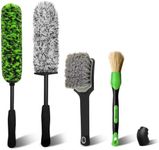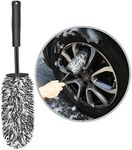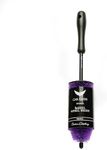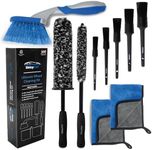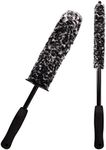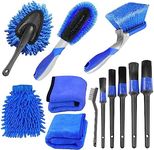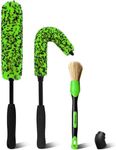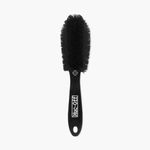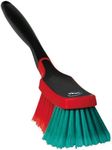Buying Guide for the Best Wheel Brushes
Choosing the right wheel brush can make a significant difference in maintaining the cleanliness and appearance of your vehicle's wheels. Wheel brushes are designed to reach into the crevices and contours of wheels, removing dirt, brake dust, and grime effectively. When selecting a wheel brush, consider the type of wheels you have, the level of dirt accumulation, and how often you plan to clean your wheels. The right brush will not only clean efficiently but also protect your wheels from scratches and damage.Bristle MaterialThe bristle material of a wheel brush is crucial because it determines how effectively the brush can clean and how gentle it is on your wheels. Common materials include synthetic fibers, natural fibers, and metal bristles. Synthetic fibers are durable and can handle tough grime without scratching the surface, making them ideal for most wheels. Natural fibers are softer and better suited for delicate finishes. Metal bristles are more abrasive and should be used with caution, typically for heavy-duty cleaning. Choose a bristle material based on the sensitivity of your wheel's finish and the level of dirt you need to remove.
Brush Size and ShapeThe size and shape of a wheel brush affect its ability to reach different areas of the wheel. Smaller brushes can access tight spaces and intricate designs, while larger brushes cover more surface area quickly. Some brushes have a tapered shape to reach deep into the wheel's crevices, while others are flat for general cleaning. Consider the design of your wheels and the areas you need to clean most often. If your wheels have complex designs, opt for a brush with a shape that can navigate those contours effectively.
Handle LengthHandle length is important for comfort and control during cleaning. A longer handle allows you to reach deeper into the wheel wells without straining, while a shorter handle offers more precision and control for detailed cleaning. If you have larger wheels or need to clean the inner parts of the wheel, a longer handle might be more suitable. For smaller wheels or detailed work, a shorter handle can provide better maneuverability. Consider your comfort and the areas you need to clean when choosing the handle length.
DurabilityDurability refers to how well the wheel brush can withstand repeated use and exposure to cleaning chemicals. A durable brush will last longer and maintain its effectiveness over time. Look for brushes made with high-quality materials that resist wear and tear. If you clean your wheels frequently or use strong cleaning agents, prioritize durability to ensure your brush remains functional and effective. Assess your cleaning habits and choose a brush that can handle the frequency and intensity of your cleaning routine.
Ease of CleaningEase of cleaning is about how simple it is to clean the brush itself after use. A brush that is easy to clean will maintain its performance and hygiene, preventing the buildup of dirt and grime. Some brushes have removable heads or bristles that can be rinsed easily, while others may require more effort to clean. Consider how often you plan to clean your brush and how much time you're willing to spend on maintenance. If you prefer a low-maintenance option, look for brushes designed for easy cleaning.


